|
Tags: development | JCRR | KMT
I. Preface
After retreating to Taiwan, the Republic of China's (ROC) Kuomintang government became determined to improve the people's lives. In addition to building basic infrastructure and implementing social and spiritual measures, it promoted land reform. With US aid, it established the Sino-American Joint Commission on Rural Construction (JCRR) to push forward various rural projects. The US Economic Cooperation Agency (ECA) (later reorganized into the Mutual Security Agency; MSA) supplied Taiwan with essential goods such as flour and powder milk.
Under the leadership of JCRR Chairman Mon-Lin Chiang U.S. specialists introduced new agricultural knowledge and techniques into Taiwan. Through farmers' associations, it worked to improve farmer's lives and adding to their knowledge by promoting education, which included moves to increase literacy, birth control, pest control, how to balance one's diet, and methods to increase agricultural production.
At the same time, JCRR specialists taught rural women home economics as well as sanitation. Moreover, JCRR specialists cooperated with foreign rural development experts to promote education and job opportunities for rural teens.
Let's look back at Taiwan's rural development in the 1950s and 1960s through photographs. These photographs are presented under four themes: "Life," "Women," "Youth," and "Children."
The "Life" theme presents the true face of Taiwan's rural villages and life in these years; the section entitled "Women" portrays the diligence of rural women in running their homes as well as their participation in rural home economics classes; "Youth" shows how young people learned various kinds of agricultural skills through participating in 4-H Club extension education; and the pictures of the "Children" section introduces the home and school life of children in rural and urban regions.
Through these vivid pictures, the difficulties our predecessors faced in reclaiming the land with but the most minimum of resources are revealed. These images of them raising cattle and plowing fields under the scorching sun may help the younger generation appreciating the hard work of their forebears.
II. Life
|

A man is plastering cement over a wooden wall.
Photo by: GIO Photographer (1952-00-00)
|
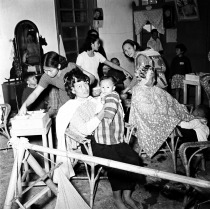
Women are having their hair permed at a hair salon.
Photo by: GIO Photographer (1952-00-00)
|

A man uses an ox to transport a heavy load.
Photo by: GIO Photographer (1952-00-00)
|
|

A picture of Vice President Chen Cheng speaking on Farmers' Day, Feb. 4, 1955.
Photo by: GIO Photographer (1955-00-00)
|

Small tractors were introduced from Japan to Taiwan in 1955 to replace cattle.
Photo by: Transfer from JCRR (Joint Commission on Rural Reconstruction) (1956-00-00)
|
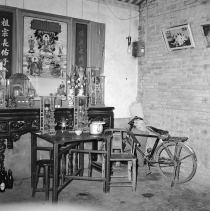
The altar of a farmhouse for worshipping ancestors as well as deities.
Photo by: Transfer from JCRR (Joint Commission on Rural Reconstruction) (1956-00-00)
|
In the 1950s, Taiwan was still an agrarian society. Life was hard. People in the countryside traveled on foot or by oxcart, with the better-off being able to afford a bicycle. Farmers' houses were old and made of bamboo and earth.
At the time, land was in the hand of just a few rich landlords, while tenant farmers were left with little for themselves after paying the rent and taxes. Premier Chen Cheng (who later became vice president) set in motion a series of land reform measures, which included: rent reductions, sales of public land, and a land-to-the-tiller program. Owning the land gave confidence to farmers, who went on to improve the land and make investments in agricultural production. This raised per-hectare yield as well as farmers' income and improved their living environment. As a result, rural villages began to prosper.
Agriculture was Taiwan's primary industry in the 1950s and 1960s. At that time, both food and cash crops, such as rice, sweet potatoes, granulated sugar, and bananas were produced. Bananas were once grown on 50,000 hectares, at which time more than 600,000 tons of the fruit was produced, mainly for export to Japan, earning Taiwan the nickname "Banana Kingdom." Other export crops such as mushrooms, asparagus, and tomatoes also brought in considerable foreign exchange.
With economic development came farm mechanization, research into and improvements to production techniques, and the introduction of electric equipment, which boosted agricultural production and farmers' income. As their standard of living increased, farmers began to play a key role in social stability and set in motion overall development. Later, rapid industrial development, economic growth, and the universalization of education, industry in Taiwan as well as social welfare became advanced. These improvements turned Taiwan into one of the 1980s and 1990s' "Four Asian Tigers."
The contribution of agriculture, rural villages, and farmers to Taiwan's achievements must not be overlooked. Let's look back at the lifestyle of those years and breathe in the fragrance of the land and its fruits. Perhaps we may get a feel for the notion "as you sow, so shall you reap" as we visualize the hard work and experience the spirit of Taiwan's farmers.
III. Women
|
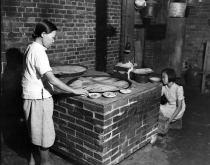
A person is preparing food in the kitchen in 1952.
Photo by: GIO Photographer (1952-00-00)
|
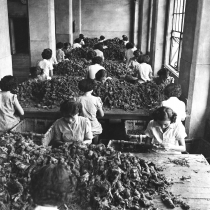
Workers are processing tobacco leaves in a factory.
Photo by: GIO Photographer (1952-00-00)
|
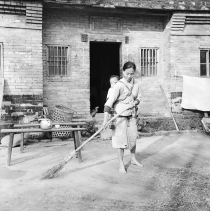
A rural woman, carrying her baby on the back, is sweeping the yard in the morning.
Photo by: GIO Photographer (1955-00-00)
|
|

Before washing machines became popular, rural women used to wash clothes in rivers.
Photo by: Transfer from JCRR (Joint Commission on Rural Reconstruction) (1955-00-00)
|
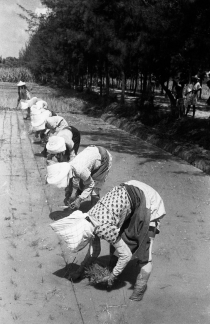
Farmers are transplanting rice seedlings in the fields.
Photo by: GIO Photographer (1955-00-00)
|

A woman puts leftovers in a refrigerator, one of the major export items of the 1960s.
Transfer from JCRR (Joint Commission on Rural Reconstruction) (1963-00-00)
|
Getting up in the 1950s, a rural woman had to manage the supply of seven items: fuel, rice, oil, salt, soy sauce, vinegar, and tea. Wood and hay were used for fuel, and it was not an easy task to collect these items and build a fire every day.
Washing machines and running water were unheard of at this time, and women had to do the laundry by a stream or well; while washing they chatted with each other and, therefore, riverbanks became a center for the sharing of news.
In addition to household duties, women were also in charge of many agricultural tasks, such as transplanting rice seedlings, harvesting rice, weeding, applying fertilizer, and spraying insecticides. Not until the use of rice cookers and refrigerators became widespread in the 1960s could rural women begin to relax a little.
In 1956, the JCRR acted through farmers' associations to promote "home economics and education" and establish "home improvement classes." With that, rural women had the opportunity to receive training in various fields, including reading, knowledge of birth control, nutrition, healthcare, cooking, family health, and baby care. This not only helped the personal growth and development of the participating women but contributed to the development of farming households and entire villages.
From these photos, we can feel the hardship of rural women in those years and further understand their contribution to Taiwan's rural development.
IV. Youth
|

A number of 4-H Club members at Taoyuan Senior Agricultural School celebrate their success in breeding rabbits.
Photo by: Transfer from JCRR (Joint Commission on Rural Reconstruction) (1953-00-00)
|
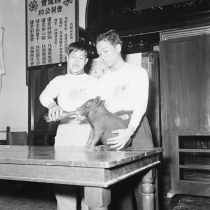
4-H Club members demonstrate how to bottle-feed piglets.
Photo by: Transfer from JCRR (Joint Commission on Rural Reconstruction) (1955-00-00)
|
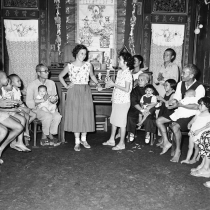
A guest from the US is learning the Oriental way of life by interacting with Taiwanese women.
Photo by: Transfer from JCRR (Joint Commission on Rural Reconstruction) (1957-00-00)
|
|
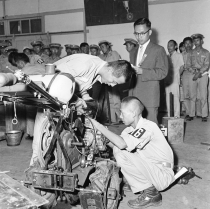
Contestants examine the engine of a Liberty Brand tractor.
Photo by: Transfer from JCRR (Joint Commission on Rural Reconstruction) (1959-00-00)
|
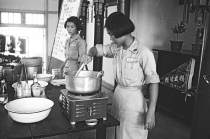
Students demonstrate their skill in cooking.
Photo by: Transfer from JCRR (Joint Commission on Rural Reconstruction) (1959-00-00)
|
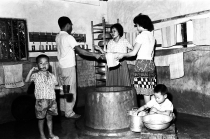
A Taoyuan 4-H Club worker visits a farmer's family.
Photo by: Transfer from JCRR (Joint Commission on Rural Reconstruction) (1962-00-00)
|
In the 1950s Taiwan was still quite underdeveloped. JCRR Chairman Chiang Mon-lin conceived that youth, as the core of future society, should receive training as farmers and be equipped with scientific knowledge and skills. Therefore, he introduced the 4-H Club from the United States, considering it crucial to improving agriculture in Taiwan.
The first "Campus 4-H Club" in Taiwan was organized at Chiayi Senior Agricultural Vocational School in 1952. The first "Rural 4-H Club" came into being in Dalin Township, Chiayi County in the same year. Thereafter, 4-H clubs sprouted one after another in villages across the island. By 1966, clubs were operating in 285 towns and 65 agricultural schools and had a total membership of more than 80,000.
The rapid development of commerce and industry has meant the value of agricultural production in proportion to the value of manufacturing has shrunk year after year. The rural population declined; therefore so did the number of rural youth. This trend triggered a transformation of the 4-H Club. The organization is no longer found only in rural areas. Urban schools may also apply to host 4-H clubs. The 4H Club is still active in Taiwan and has trained 600,000 youth.
Certain outstanding 4-H Club members have had the opportunity to visit foreign countries under the International 4-H Youth Exchange Program (IFYE) to serve as "Grassroots Ambassadors."
Countries that have exchanged "Grassroots Ambassadors" with Taiwan include the US, Denmark, Japan, Germany, Costa Rica, Thailand, the Philippines, Vietnam, Switzerland, Korea, and Sweden. As of 2005, Taiwan had sent more than 800 "Grassroots Ambassadors" abroad.
4-H Club: Please visit the website of the National 4-H Club Association of the R.O.C. at http://www.fourh.org.tw.; International 4H Youth Exchange Program: Please visit the National IFYE Association of the R.O.C. at http://www.ifye.org.tw.
V. Children
|
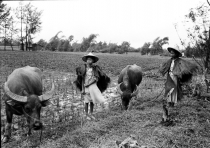
Children are herding cattle in a field in 1952.
Photo by: GIO Photographer (1952-00-00)
|
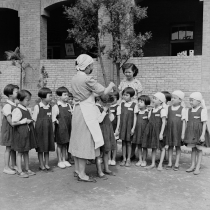
Several students cover their eyes and noses while public health personnel apply anti-lice powder to their hair.
Photo by: Transfer from JCRR (Joint Commission on Rural Reconstruction) (1953-00-00)
|
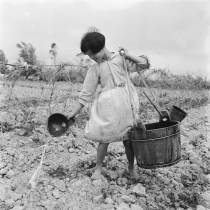
A farm girl uses a pole to carry water to a field to water plants.
Photo by: Transfer from JCRR (Joint Commission on Rural Reconstruction) (1955-00-00)
|
|
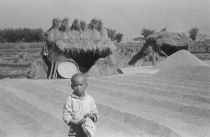
A child is standing in front of a field where there are some grain piles and rice straw piles and grain is being dried, photographed in 1955.
Photo by: GIO Photographer (1955-00-00)
|

Adults make steamed bread with flour donated by the US while children look on expectantly.
Photo by: Transfer from JCRR (Joint Commission on Rural Reconstruction) (1963-00-00)
|
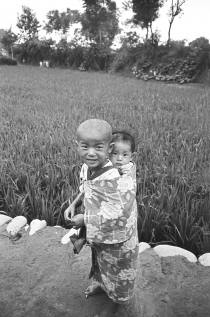
A child carries a baby on its back.
Photo by: Transfer from JCRR (Joint Commission on Rural Reconstruction) (1963-00-00)
|
Children are the future of a nation. Although the children of the 1950s lived in material poverty, they grew into a dynamic force that created Taiwan's economic miracle.
In the 1950s and 1960s, Taiwan was plagued by material deprivation. It was supported by US donations of daily necessities like flour and milk powder. After the contents were used, Taiwan's shrewd mothers sewed flour sacks bearing the image of a handshake (the logo of US aid) and the words "Sino-American Cooperation" into T-shirt and shorts for their children. Taiwan's people had little to eat. The most common food was a bowl of rice dressed with pork lard and soy sauce.
The annual birth rate at this time exceeded three percent; therefore, every family had comparatively more children than now. Because parents were fully occupied with farming, they seldom had extra energy to spend on their children. A common sight on the streets of Taiwan was larger children carrying smaller children on their backs, as the elder sibling was often in charge of looking after the younger.
Usually, children had to help out with the farming after school. Such chores included drying unhusked rice in the sun, feeding cattle, chickens, and ducks, as well as picking grasses.
A poor hygienic environment led to the spread of parasites. Head lice and roundworm infection was commonplace. In addition to teaching better personal hygiene, school authorities assembled students for regular checks for head lice, roundworms, trachoma, tuberculosis, and malaria and also vaccinated children.
In these photos, we can see the differences in the clothing of urban and rural children, which shows the gap in their standard of living. Looking through these photos, do they remind you of your own childhood? For those who are a bit older, these pictures may echo your own formative years, and you may find that you have kindred spirits in Taiwan.
Taiwan Image - Photo Archive
Text and images are provided by Ministry of Foreign Affairs, Republic of China (TAIWAN)
|



































